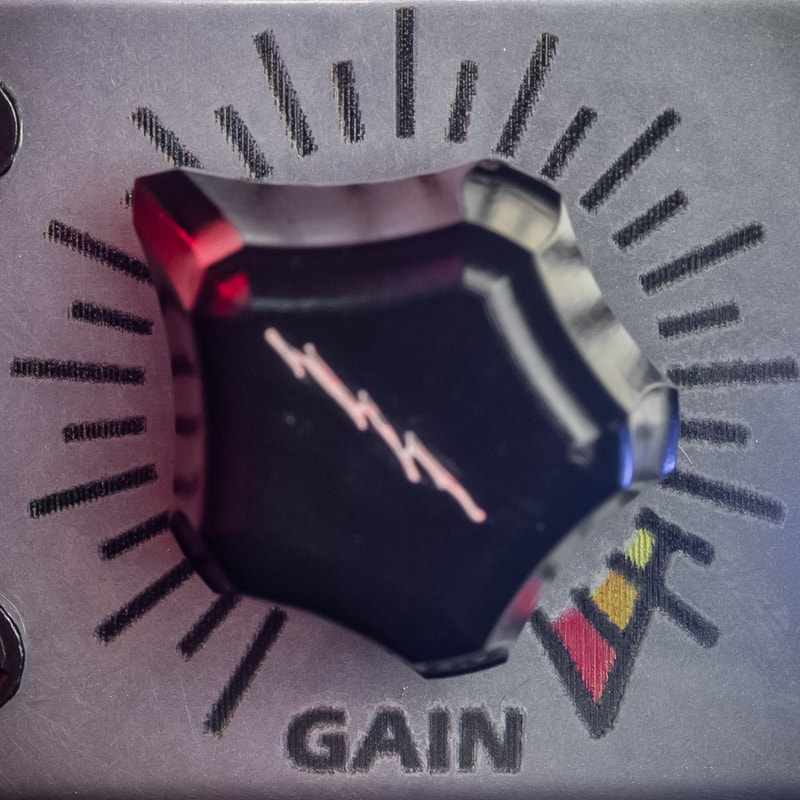|
|
|
Seen above is the 75dB, JFET powered, 4-transformer, "Dark Storm" preamp. This is more than just a mic preamp. It's an instrument preamp with a 1/4" out as well. The dual outputs can work at the same time - a 600 Ohm balanced XLR output and a Hi-Z 1/4 unbalanced output (wet). With the gain knob up all the way you can get strong and fuzzy distortion (depending on the volume of the source). In her cleanest configuration, the Dark Storm has a tastefully clean 0.018% THD+N and a frequency response that spans from 10Hz-400kHz (+/-2dB from 13Hz-25.5kHz). Recording ribbon mics is a breeze for the Dark Storm's 75dB of gain and S/N ratio of 100dB. The "Old" button gives a round vintage-like tone and 12dB of boost. When bypassed it's a very modern high-detail sound. The gain knob adds color and can provide about 38dB of boost. You can get anything from sparkling clean to super dirty sounds out of the Dark Storm.
The "Old" switch can radically alter the tone of the Dark Storm. For starters, it sounds more like a vintage piece of gear. It does this by switching to a different impedance tap on the custom-wound LBA-MCX4 mic input transformer. This tap is one that aligns closely with that of mic input transformers from the late 1950's-early 1960's. When this is engaged, a 12dB boost in volume is also achieved. The frequency response is reduced a little and the harmonic content is increased a little by this switch. Normally, the frequency response is exceptionally flat throughout the bandwidth of 13Hz-25.5kHz. The Old switch brings it back to old-school territory with a flat zone of 34Hz-23.3kHz. The sound of this function can be described as one that is more focused and round with a tone that is not overbearing. A lot of clarity can be maintained, but certainly some will be sacrificed when using the Old feature.
The "Old" switch can radically alter the tone of the Dark Storm. For starters, it sounds more like a vintage piece of gear. It does this by switching to a different impedance tap on the custom-wound LBA-MCX4 mic input transformer. This tap is one that aligns closely with that of mic input transformers from the late 1950's-early 1960's. When this is engaged, a 12dB boost in volume is also achieved. The frequency response is reduced a little and the harmonic content is increased a little by this switch. Normally, the frequency response is exceptionally flat throughout the bandwidth of 13Hz-25.5kHz. The Old switch brings it back to old-school territory with a flat zone of 34Hz-23.3kHz. The sound of this function can be described as one that is more focused and round with a tone that is not overbearing. A lot of clarity can be maintained, but certainly some will be sacrificed when using the Old feature.
|
The Gain knob is an active control for the mic preamp stage. It can add thickness and when pushed beyond half way, distortion. With the gain all the way down audio will pass with about 25dB of gain and audibly more headroom than any other configuration. Up all the way an you can get a fuzz-like distortion. At >95% of the knob's rotation is where you dig into the distortion. During the prototyping stage I removed the ability to get audible distortion from the gain knob and very shortly after decided it was best to put it back in. It's a cool sound that's proven to be useful in my studio work.
|
|
The Trim knob is a passive volume attenuator which comes post input section, but before the output amplification stage and output transformer(s). It can allow the user to dial in loads of gain (or distortion) and then attenuate the output volume to a suitable level. There are dual outputs which can be used at the same time. There is a transformer balanced +4dBu XLR line output, which uses a massive "LBA-Fat Sally 0.2" output transformer. In parallel with the output of this transformer is an LBA-20SX steel-core transformer, which converts the 600 Ohm output to 145k Ohms for the Hi-Z 1/4" output. This 1/4" output can be fed to FX pedals, an instrument amplifier, or to a power amp. When using the DI input and the 1/4" output, your signal will be going through all 4 transformers. A microphone source to the XLR out will run through 2 of the transformers, but the 1/4" transformer coupled output can also be utilized simultaneously. That might be useful for tracking in a DAW with high latency, as you could run the XLR into the DAW and the 1/4" to an external mixer/headphone amp for latency-free monitoring.
There is a passive Low-Cut filter switch at 58Hz with a 10dB per octave slope. There's also phantom power and a polarity reversal switch. On the back side are ground lift switches for both the 1/4" and XLR outputs separately. The Dark Storm is powered by a 48VDC international power adapter, which is sold separately here. An IEC cable will be included for North American buyers. The Dark Storm is housed in a 1U half-rack enclosure and will come with adhesive gel feet attached. A stereo pair factory racked into a 19" enclosure with rack ears is an option. Rack ears can be purchased separately if you wish to rack mount a Dark Storm in a half rack. |
|
The Dark Storm is available for $949.99 USD or $1899.99 for a 19" rack-mount double Dark Storm. ORDER HERE.
Check out this video demo in which Kristian, of the Youtube Channel, Kohle Audio Kult, compares the Dark Storm's DI feature against several other DI solutions on the market. We think he secretly loves the Dark Storm. What do you think?
Technical Information:
- Topology: Class A, single-ended
- Gain: 75dB Max +/- 2dB
- S/N Ratio: 100dB A-weighted
- THD: Measured with the "Old" switch not depressed and the "Gain" knob turned all the way down. With a low impedance 1kHz 150mV sine wave applied to the XLR input the measured THD+N=0.018% at the XLR output.
- Frequency Response:
- XLR in to XLR out: "Old" bypassed = +/-2dB from 13Hz-25.5kHz. With "Old" engaged +/-2dB from 34Hz-23.3kHz.
- Input impedance: XLR = 1.4k Ohms or 150 Ohms with the "Old" switch engaged. 1/4" (front panel) = 1M Ohms.
- Output Impedance: XLR = 600 Ohms. 1/4" (rear Panel) 145k Ohms.
- Dimensions: (LxWxH) 8.5"x8.5"x2"/21.6cm/21.6cm/5.1cm
- Weight: 2.88lbs/1.3kg, shipping weight 6lbs.
- Current demand: 57mA with no condenser microphone connected. A condenser mic will draw additional current.
- Power Requirements: 48V DC power adapter sold separately, 2.5mm center pin positive. The power supply sold by LBA will work internationally. International buyers must supply their own IEC power cable to connect the power supply to an AC power outlet.




